The Impact of Globalization on Siemens: Context, Risks, and Practices
VerifiedAdded on 2021/04/17
|7
|2088
|166
Essay
AI Summary
This essay provides a comprehensive analysis of Siemens, a major industrial manufacturing company, within the context of globalization. It begins by outlining Siemens' organizational structure, emphasizing its global presence and key business divisions like Energy, Industry, and Healthcare. The essay then delves into the multifaceted impacts of globalization on Siemens, including the need to adapt to global market trends, manage increased competition, and navigate financial, economic, and societal risks. It highlights the importance of internal factors, such as branding and employee capabilities, and external factors, like market environments and regulations. The essay further explores the risks associated with globalization, such as competition from domestic companies, currency exchange rate fluctuations, and societal acceptance of products. To enhance organizational performance, the essay suggests Siemens focus on high-performance culture, employee engagement, benchmarking, and strategic planning. It also emphasizes the importance of integrating business functions like operations, finance, human resources, and marketing to achieve strategic goals. The conclusion reiterates the significant impact of globalization on Siemens and the importance of strategic business practices for continued success.
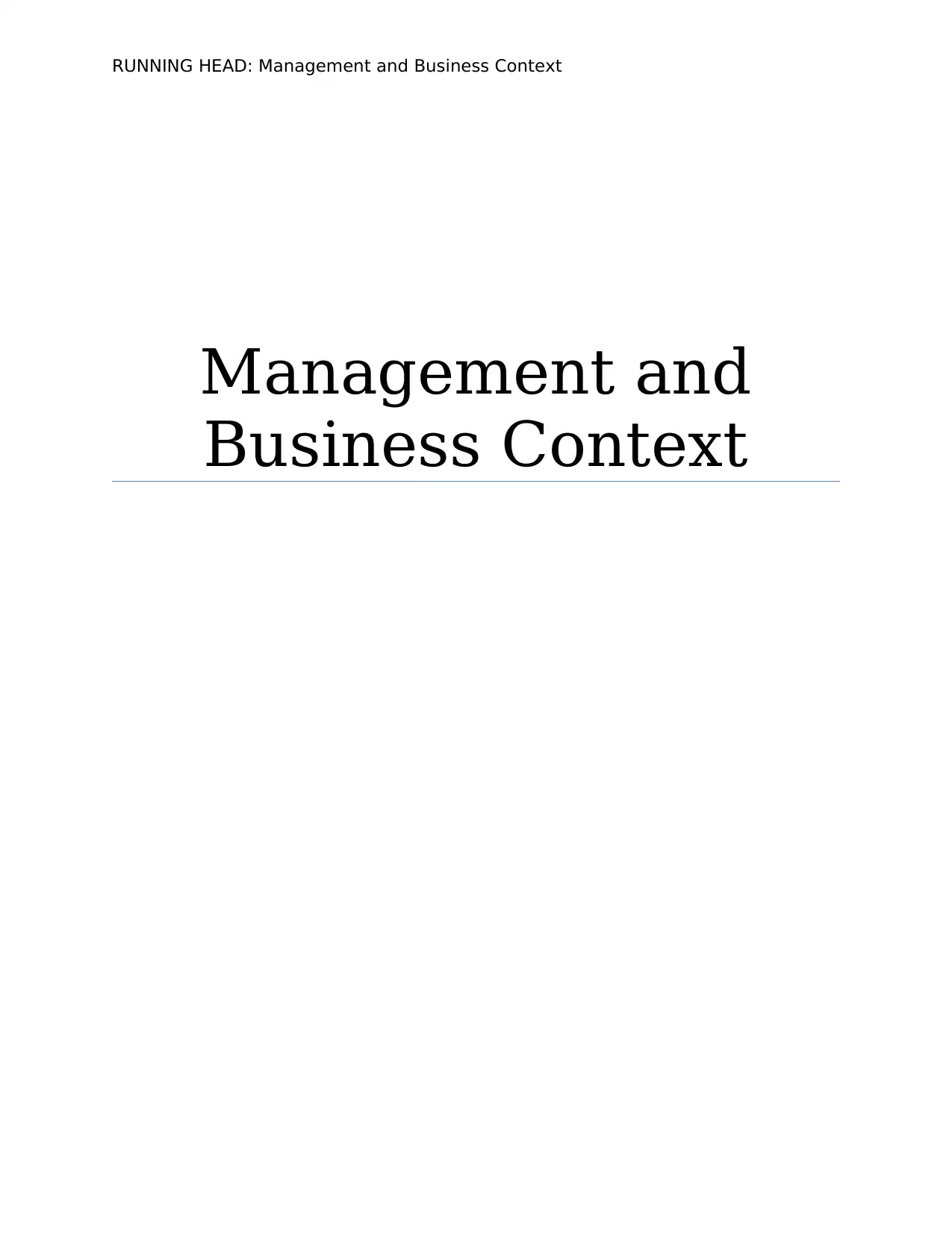
RUNNING HEAD: Management and Business Context
Management and
Business Context
Management and
Business Context
Paraphrase This Document
Need a fresh take? Get an instant paraphrase of this document with our AI Paraphraser
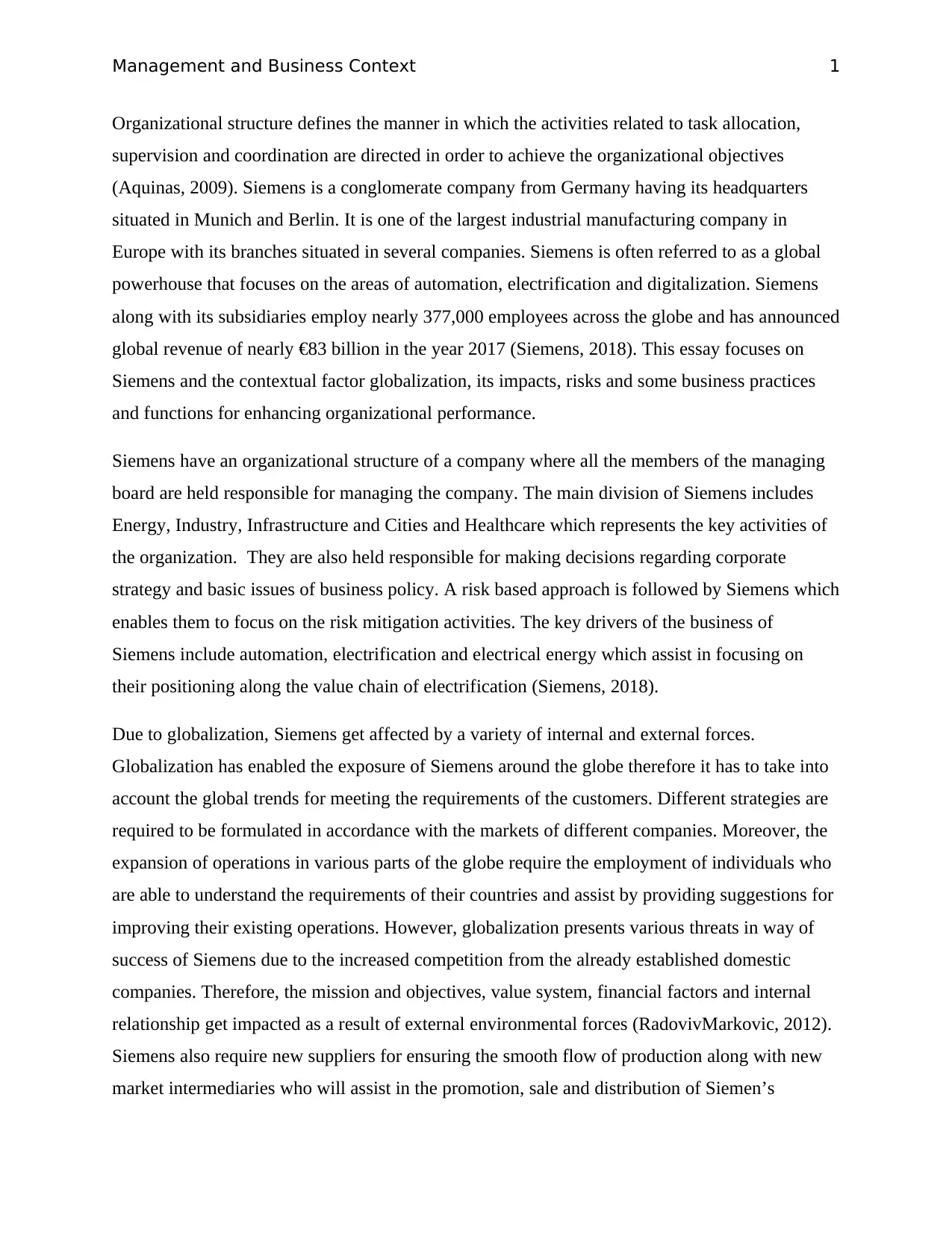
Management and Business Context 1
Organizational structure defines the manner in which the activities related to task allocation,
supervision and coordination are directed in order to achieve the organizational objectives
(Aquinas, 2009). Siemens is a conglomerate company from Germany having its headquarters
situated in Munich and Berlin. It is one of the largest industrial manufacturing company in
Europe with its branches situated in several companies. Siemens is often referred to as a global
powerhouse that focuses on the areas of automation, electrification and digitalization. Siemens
along with its subsidiaries employ nearly 377,000 employees across the globe and has announced
global revenue of nearly €83 billion in the year 2017 (Siemens, 2018). This essay focuses on
Siemens and the contextual factor globalization, its impacts, risks and some business practices
and functions for enhancing organizational performance.
Siemens have an organizational structure of a company where all the members of the managing
board are held responsible for managing the company. The main division of Siemens includes
Energy, Industry, Infrastructure and Cities and Healthcare which represents the key activities of
the organization. They are also held responsible for making decisions regarding corporate
strategy and basic issues of business policy. A risk based approach is followed by Siemens which
enables them to focus on the risk mitigation activities. The key drivers of the business of
Siemens include automation, electrification and electrical energy which assist in focusing on
their positioning along the value chain of electrification (Siemens, 2018).
Due to globalization, Siemens get affected by a variety of internal and external forces.
Globalization has enabled the exposure of Siemens around the globe therefore it has to take into
account the global trends for meeting the requirements of the customers. Different strategies are
required to be formulated in accordance with the markets of different companies. Moreover, the
expansion of operations in various parts of the globe require the employment of individuals who
are able to understand the requirements of their countries and assist by providing suggestions for
improving their existing operations. However, globalization presents various threats in way of
success of Siemens due to the increased competition from the already established domestic
companies. Therefore, the mission and objectives, value system, financial factors and internal
relationship get impacted as a result of external environmental forces (RadovivMarkovic, 2012).
Siemens also require new suppliers for ensuring the smooth flow of production along with new
market intermediaries who will assist in the promotion, sale and distribution of Siemen’s
Organizational structure defines the manner in which the activities related to task allocation,
supervision and coordination are directed in order to achieve the organizational objectives
(Aquinas, 2009). Siemens is a conglomerate company from Germany having its headquarters
situated in Munich and Berlin. It is one of the largest industrial manufacturing company in
Europe with its branches situated in several companies. Siemens is often referred to as a global
powerhouse that focuses on the areas of automation, electrification and digitalization. Siemens
along with its subsidiaries employ nearly 377,000 employees across the globe and has announced
global revenue of nearly €83 billion in the year 2017 (Siemens, 2018). This essay focuses on
Siemens and the contextual factor globalization, its impacts, risks and some business practices
and functions for enhancing organizational performance.
Siemens have an organizational structure of a company where all the members of the managing
board are held responsible for managing the company. The main division of Siemens includes
Energy, Industry, Infrastructure and Cities and Healthcare which represents the key activities of
the organization. They are also held responsible for making decisions regarding corporate
strategy and basic issues of business policy. A risk based approach is followed by Siemens which
enables them to focus on the risk mitigation activities. The key drivers of the business of
Siemens include automation, electrification and electrical energy which assist in focusing on
their positioning along the value chain of electrification (Siemens, 2018).
Due to globalization, Siemens get affected by a variety of internal and external forces.
Globalization has enabled the exposure of Siemens around the globe therefore it has to take into
account the global trends for meeting the requirements of the customers. Different strategies are
required to be formulated in accordance with the markets of different companies. Moreover, the
expansion of operations in various parts of the globe require the employment of individuals who
are able to understand the requirements of their countries and assist by providing suggestions for
improving their existing operations. However, globalization presents various threats in way of
success of Siemens due to the increased competition from the already established domestic
companies. Therefore, the mission and objectives, value system, financial factors and internal
relationship get impacted as a result of external environmental forces (RadovivMarkovic, 2012).
Siemens also require new suppliers for ensuring the smooth flow of production along with new
market intermediaries who will assist in the promotion, sale and distribution of Siemen’s
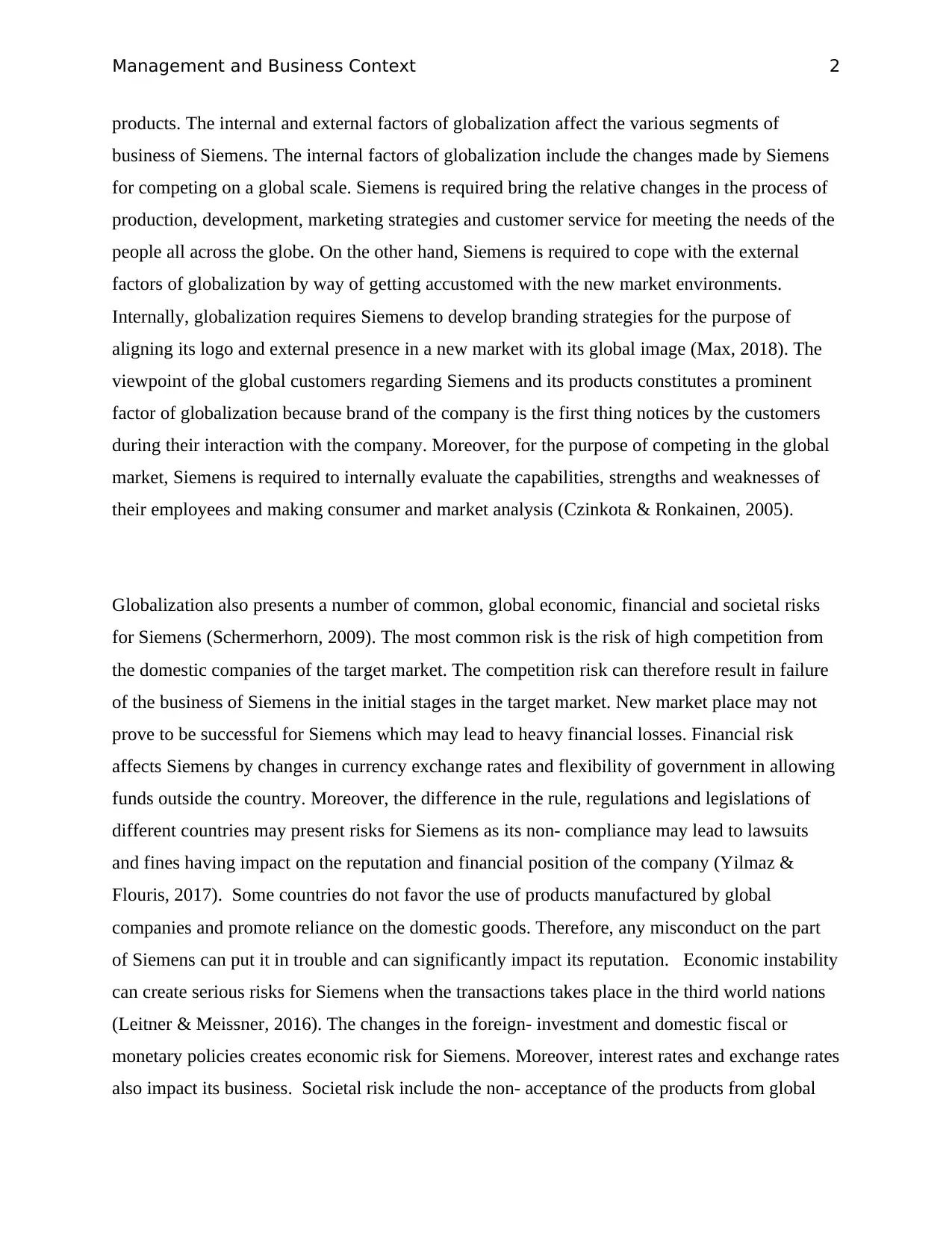
Management and Business Context 2
products. The internal and external factors of globalization affect the various segments of
business of Siemens. The internal factors of globalization include the changes made by Siemens
for competing on a global scale. Siemens is required bring the relative changes in the process of
production, development, marketing strategies and customer service for meeting the needs of the
people all across the globe. On the other hand, Siemens is required to cope with the external
factors of globalization by way of getting accustomed with the new market environments.
Internally, globalization requires Siemens to develop branding strategies for the purpose of
aligning its logo and external presence in a new market with its global image (Max, 2018). The
viewpoint of the global customers regarding Siemens and its products constitutes a prominent
factor of globalization because brand of the company is the first thing notices by the customers
during their interaction with the company. Moreover, for the purpose of competing in the global
market, Siemens is required to internally evaluate the capabilities, strengths and weaknesses of
their employees and making consumer and market analysis (Czinkota & Ronkainen, 2005).
Globalization also presents a number of common, global economic, financial and societal risks
for Siemens (Schermerhorn, 2009). The most common risk is the risk of high competition from
the domestic companies of the target market. The competition risk can therefore result in failure
of the business of Siemens in the initial stages in the target market. New market place may not
prove to be successful for Siemens which may lead to heavy financial losses. Financial risk
affects Siemens by changes in currency exchange rates and flexibility of government in allowing
funds outside the country. Moreover, the difference in the rule, regulations and legislations of
different countries may present risks for Siemens as its non- compliance may lead to lawsuits
and fines having impact on the reputation and financial position of the company (Yilmaz &
Flouris, 2017). Some countries do not favor the use of products manufactured by global
companies and promote reliance on the domestic goods. Therefore, any misconduct on the part
of Siemens can put it in trouble and can significantly impact its reputation. Economic instability
can create serious risks for Siemens when the transactions takes place in the third world nations
(Leitner & Meissner, 2016). The changes in the foreign- investment and domestic fiscal or
monetary policies creates economic risk for Siemens. Moreover, interest rates and exchange rates
also impact its business. Societal risk include the non- acceptance of the products from global
products. The internal and external factors of globalization affect the various segments of
business of Siemens. The internal factors of globalization include the changes made by Siemens
for competing on a global scale. Siemens is required bring the relative changes in the process of
production, development, marketing strategies and customer service for meeting the needs of the
people all across the globe. On the other hand, Siemens is required to cope with the external
factors of globalization by way of getting accustomed with the new market environments.
Internally, globalization requires Siemens to develop branding strategies for the purpose of
aligning its logo and external presence in a new market with its global image (Max, 2018). The
viewpoint of the global customers regarding Siemens and its products constitutes a prominent
factor of globalization because brand of the company is the first thing notices by the customers
during their interaction with the company. Moreover, for the purpose of competing in the global
market, Siemens is required to internally evaluate the capabilities, strengths and weaknesses of
their employees and making consumer and market analysis (Czinkota & Ronkainen, 2005).
Globalization also presents a number of common, global economic, financial and societal risks
for Siemens (Schermerhorn, 2009). The most common risk is the risk of high competition from
the domestic companies of the target market. The competition risk can therefore result in failure
of the business of Siemens in the initial stages in the target market. New market place may not
prove to be successful for Siemens which may lead to heavy financial losses. Financial risk
affects Siemens by changes in currency exchange rates and flexibility of government in allowing
funds outside the country. Moreover, the difference in the rule, regulations and legislations of
different countries may present risks for Siemens as its non- compliance may lead to lawsuits
and fines having impact on the reputation and financial position of the company (Yilmaz &
Flouris, 2017). Some countries do not favor the use of products manufactured by global
companies and promote reliance on the domestic goods. Therefore, any misconduct on the part
of Siemens can put it in trouble and can significantly impact its reputation. Economic instability
can create serious risks for Siemens when the transactions takes place in the third world nations
(Leitner & Meissner, 2016). The changes in the foreign- investment and domestic fiscal or
monetary policies creates economic risk for Siemens. Moreover, interest rates and exchange rates
also impact its business. Societal risk include the non- acceptance of the products from global
⊘ This is a preview!⊘
Do you want full access?
Subscribe today to unlock all pages.

Trusted by 1+ million students worldwide
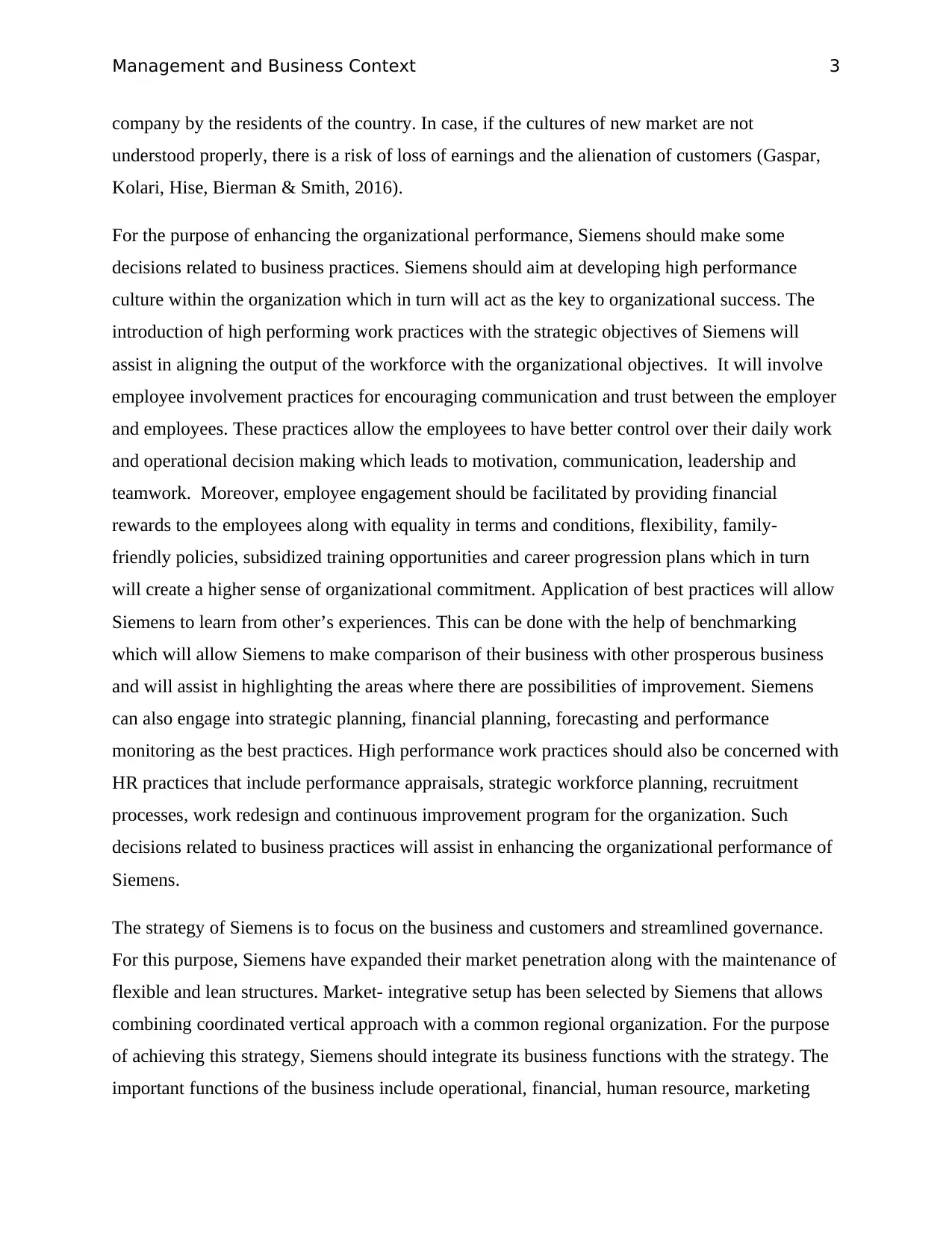
Management and Business Context 3
company by the residents of the country. In case, if the cultures of new market are not
understood properly, there is a risk of loss of earnings and the alienation of customers (Gaspar,
Kolari, Hise, Bierman & Smith, 2016).
For the purpose of enhancing the organizational performance, Siemens should make some
decisions related to business practices. Siemens should aim at developing high performance
culture within the organization which in turn will act as the key to organizational success. The
introduction of high performing work practices with the strategic objectives of Siemens will
assist in aligning the output of the workforce with the organizational objectives. It will involve
employee involvement practices for encouraging communication and trust between the employer
and employees. These practices allow the employees to have better control over their daily work
and operational decision making which leads to motivation, communication, leadership and
teamwork. Moreover, employee engagement should be facilitated by providing financial
rewards to the employees along with equality in terms and conditions, flexibility, family-
friendly policies, subsidized training opportunities and career progression plans which in turn
will create a higher sense of organizational commitment. Application of best practices will allow
Siemens to learn from other’s experiences. This can be done with the help of benchmarking
which will allow Siemens to make comparison of their business with other prosperous business
and will assist in highlighting the areas where there are possibilities of improvement. Siemens
can also engage into strategic planning, financial planning, forecasting and performance
monitoring as the best practices. High performance work practices should also be concerned with
HR practices that include performance appraisals, strategic workforce planning, recruitment
processes, work redesign and continuous improvement program for the organization. Such
decisions related to business practices will assist in enhancing the organizational performance of
Siemens.
The strategy of Siemens is to focus on the business and customers and streamlined governance.
For this purpose, Siemens have expanded their market penetration along with the maintenance of
flexible and lean structures. Market- integrative setup has been selected by Siemens that allows
combining coordinated vertical approach with a common regional organization. For the purpose
of achieving this strategy, Siemens should integrate its business functions with the strategy. The
important functions of the business include operational, financial, human resource, marketing
company by the residents of the country. In case, if the cultures of new market are not
understood properly, there is a risk of loss of earnings and the alienation of customers (Gaspar,
Kolari, Hise, Bierman & Smith, 2016).
For the purpose of enhancing the organizational performance, Siemens should make some
decisions related to business practices. Siemens should aim at developing high performance
culture within the organization which in turn will act as the key to organizational success. The
introduction of high performing work practices with the strategic objectives of Siemens will
assist in aligning the output of the workforce with the organizational objectives. It will involve
employee involvement practices for encouraging communication and trust between the employer
and employees. These practices allow the employees to have better control over their daily work
and operational decision making which leads to motivation, communication, leadership and
teamwork. Moreover, employee engagement should be facilitated by providing financial
rewards to the employees along with equality in terms and conditions, flexibility, family-
friendly policies, subsidized training opportunities and career progression plans which in turn
will create a higher sense of organizational commitment. Application of best practices will allow
Siemens to learn from other’s experiences. This can be done with the help of benchmarking
which will allow Siemens to make comparison of their business with other prosperous business
and will assist in highlighting the areas where there are possibilities of improvement. Siemens
can also engage into strategic planning, financial planning, forecasting and performance
monitoring as the best practices. High performance work practices should also be concerned with
HR practices that include performance appraisals, strategic workforce planning, recruitment
processes, work redesign and continuous improvement program for the organization. Such
decisions related to business practices will assist in enhancing the organizational performance of
Siemens.
The strategy of Siemens is to focus on the business and customers and streamlined governance.
For this purpose, Siemens have expanded their market penetration along with the maintenance of
flexible and lean structures. Market- integrative setup has been selected by Siemens that allows
combining coordinated vertical approach with a common regional organization. For the purpose
of achieving this strategy, Siemens should integrate its business functions with the strategy. The
important functions of the business include operational, financial, human resource, marketing
Paraphrase This Document
Need a fresh take? Get an instant paraphrase of this document with our AI Paraphraser
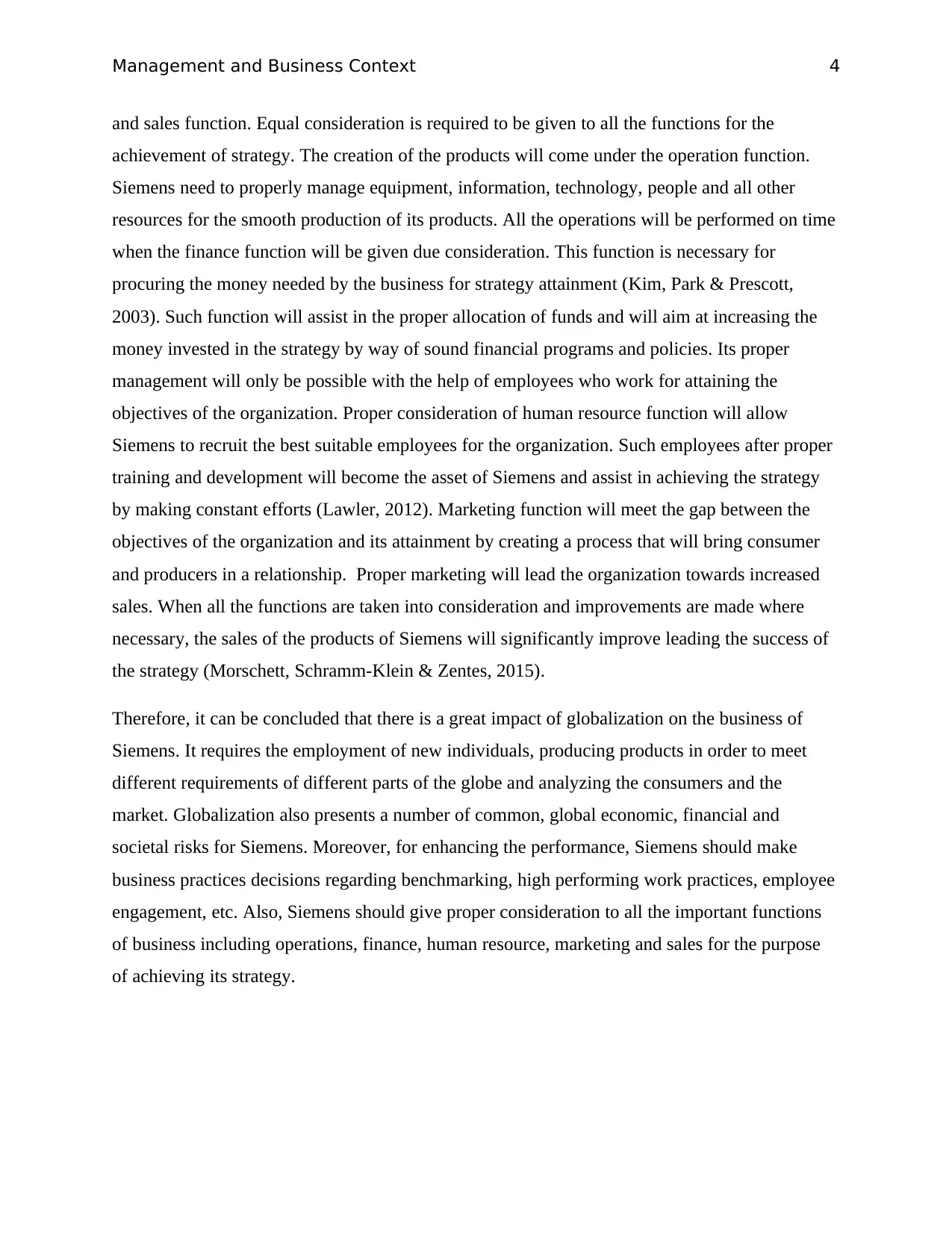
Management and Business Context 4
and sales function. Equal consideration is required to be given to all the functions for the
achievement of strategy. The creation of the products will come under the operation function.
Siemens need to properly manage equipment, information, technology, people and all other
resources for the smooth production of its products. All the operations will be performed on time
when the finance function will be given due consideration. This function is necessary for
procuring the money needed by the business for strategy attainment (Kim, Park & Prescott,
2003). Such function will assist in the proper allocation of funds and will aim at increasing the
money invested in the strategy by way of sound financial programs and policies. Its proper
management will only be possible with the help of employees who work for attaining the
objectives of the organization. Proper consideration of human resource function will allow
Siemens to recruit the best suitable employees for the organization. Such employees after proper
training and development will become the asset of Siemens and assist in achieving the strategy
by making constant efforts (Lawler, 2012). Marketing function will meet the gap between the
objectives of the organization and its attainment by creating a process that will bring consumer
and producers in a relationship. Proper marketing will lead the organization towards increased
sales. When all the functions are taken into consideration and improvements are made where
necessary, the sales of the products of Siemens will significantly improve leading the success of
the strategy (Morschett, Schramm-Klein & Zentes, 2015).
Therefore, it can be concluded that there is a great impact of globalization on the business of
Siemens. It requires the employment of new individuals, producing products in order to meet
different requirements of different parts of the globe and analyzing the consumers and the
market. Globalization also presents a number of common, global economic, financial and
societal risks for Siemens. Moreover, for enhancing the performance, Siemens should make
business practices decisions regarding benchmarking, high performing work practices, employee
engagement, etc. Also, Siemens should give proper consideration to all the important functions
of business including operations, finance, human resource, marketing and sales for the purpose
of achieving its strategy.
and sales function. Equal consideration is required to be given to all the functions for the
achievement of strategy. The creation of the products will come under the operation function.
Siemens need to properly manage equipment, information, technology, people and all other
resources for the smooth production of its products. All the operations will be performed on time
when the finance function will be given due consideration. This function is necessary for
procuring the money needed by the business for strategy attainment (Kim, Park & Prescott,
2003). Such function will assist in the proper allocation of funds and will aim at increasing the
money invested in the strategy by way of sound financial programs and policies. Its proper
management will only be possible with the help of employees who work for attaining the
objectives of the organization. Proper consideration of human resource function will allow
Siemens to recruit the best suitable employees for the organization. Such employees after proper
training and development will become the asset of Siemens and assist in achieving the strategy
by making constant efforts (Lawler, 2012). Marketing function will meet the gap between the
objectives of the organization and its attainment by creating a process that will bring consumer
and producers in a relationship. Proper marketing will lead the organization towards increased
sales. When all the functions are taken into consideration and improvements are made where
necessary, the sales of the products of Siemens will significantly improve leading the success of
the strategy (Morschett, Schramm-Klein & Zentes, 2015).
Therefore, it can be concluded that there is a great impact of globalization on the business of
Siemens. It requires the employment of new individuals, producing products in order to meet
different requirements of different parts of the globe and analyzing the consumers and the
market. Globalization also presents a number of common, global economic, financial and
societal risks for Siemens. Moreover, for enhancing the performance, Siemens should make
business practices decisions regarding benchmarking, high performing work practices, employee
engagement, etc. Also, Siemens should give proper consideration to all the important functions
of business including operations, finance, human resource, marketing and sales for the purpose
of achieving its strategy.
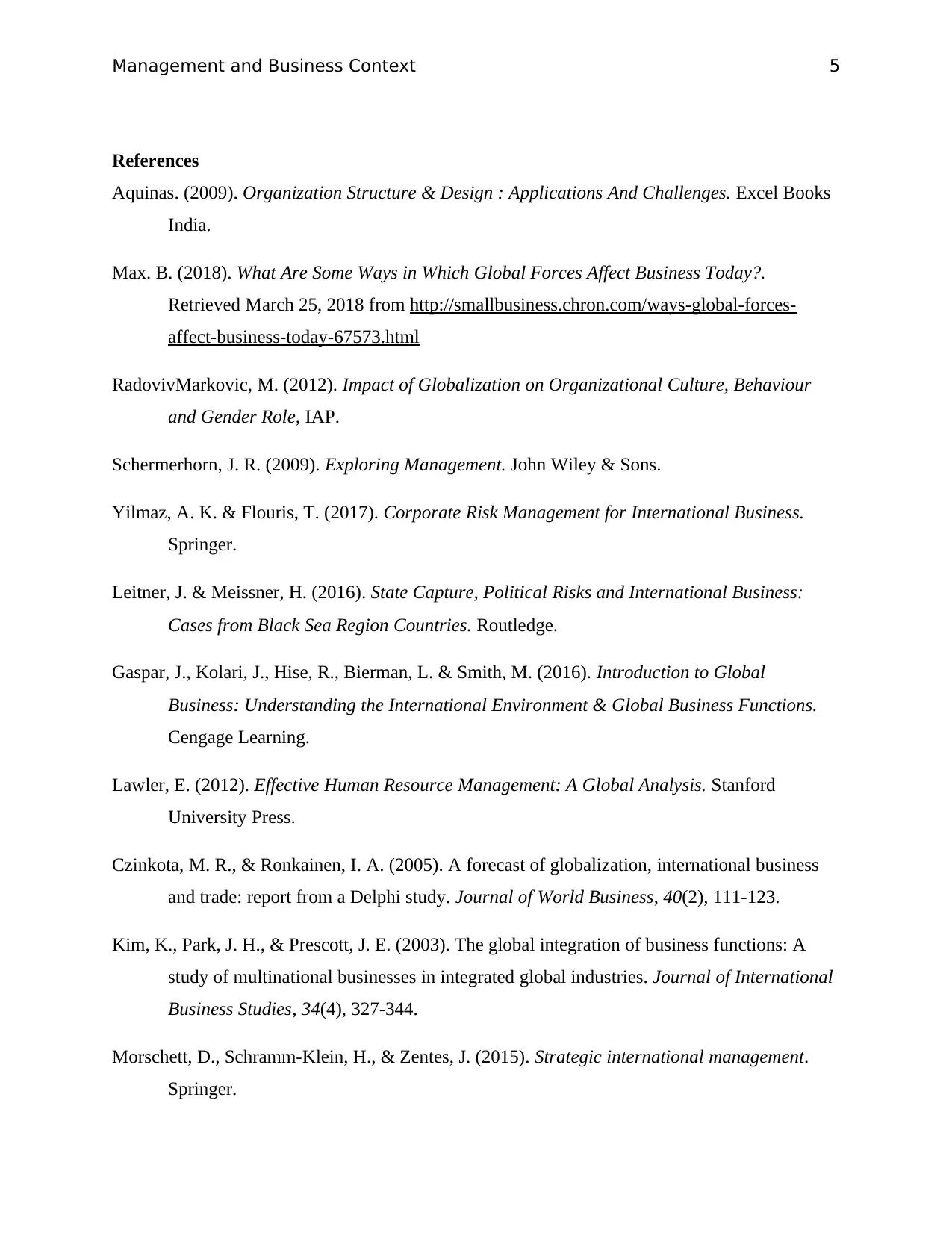
Management and Business Context 5
References
Aquinas. (2009). Organization Structure & Design : Applications And Challenges. Excel Books
India.
Max. B. (2018). What Are Some Ways in Which Global Forces Affect Business Today?.
Retrieved March 25, 2018 from http://smallbusiness.chron.com/ways-global-forces-
affect-business-today-67573.html
RadovivMarkovic, M. (2012). Impact of Globalization on Organizational Culture, Behaviour
and Gender Role, IAP.
Schermerhorn, J. R. (2009). Exploring Management. John Wiley & Sons.
Yilmaz, A. K. & Flouris, T. (2017). Corporate Risk Management for International Business.
Springer.
Leitner, J. & Meissner, H. (2016). State Capture, Political Risks and International Business:
Cases from Black Sea Region Countries. Routledge.
Gaspar, J., Kolari, J., Hise, R., Bierman, L. & Smith, M. (2016). Introduction to Global
Business: Understanding the International Environment & Global Business Functions.
Cengage Learning.
Lawler, E. (2012). Effective Human Resource Management: A Global Analysis. Stanford
University Press.
Czinkota, M. R., & Ronkainen, I. A. (2005). A forecast of globalization, international business
and trade: report from a Delphi study. Journal of World Business, 40(2), 111-123.
Kim, K., Park, J. H., & Prescott, J. E. (2003). The global integration of business functions: A
study of multinational businesses in integrated global industries. Journal of International
Business Studies, 34(4), 327-344.
Morschett, D., Schramm-Klein, H., & Zentes, J. (2015). Strategic international management.
Springer.
References
Aquinas. (2009). Organization Structure & Design : Applications And Challenges. Excel Books
India.
Max. B. (2018). What Are Some Ways in Which Global Forces Affect Business Today?.
Retrieved March 25, 2018 from http://smallbusiness.chron.com/ways-global-forces-
affect-business-today-67573.html
RadovivMarkovic, M. (2012). Impact of Globalization on Organizational Culture, Behaviour
and Gender Role, IAP.
Schermerhorn, J. R. (2009). Exploring Management. John Wiley & Sons.
Yilmaz, A. K. & Flouris, T. (2017). Corporate Risk Management for International Business.
Springer.
Leitner, J. & Meissner, H. (2016). State Capture, Political Risks and International Business:
Cases from Black Sea Region Countries. Routledge.
Gaspar, J., Kolari, J., Hise, R., Bierman, L. & Smith, M. (2016). Introduction to Global
Business: Understanding the International Environment & Global Business Functions.
Cengage Learning.
Lawler, E. (2012). Effective Human Resource Management: A Global Analysis. Stanford
University Press.
Czinkota, M. R., & Ronkainen, I. A. (2005). A forecast of globalization, international business
and trade: report from a Delphi study. Journal of World Business, 40(2), 111-123.
Kim, K., Park, J. H., & Prescott, J. E. (2003). The global integration of business functions: A
study of multinational businesses in integrated global industries. Journal of International
Business Studies, 34(4), 327-344.
Morschett, D., Schramm-Klein, H., & Zentes, J. (2015). Strategic international management.
Springer.
⊘ This is a preview!⊘
Do you want full access?
Subscribe today to unlock all pages.

Trusted by 1+ million students worldwide
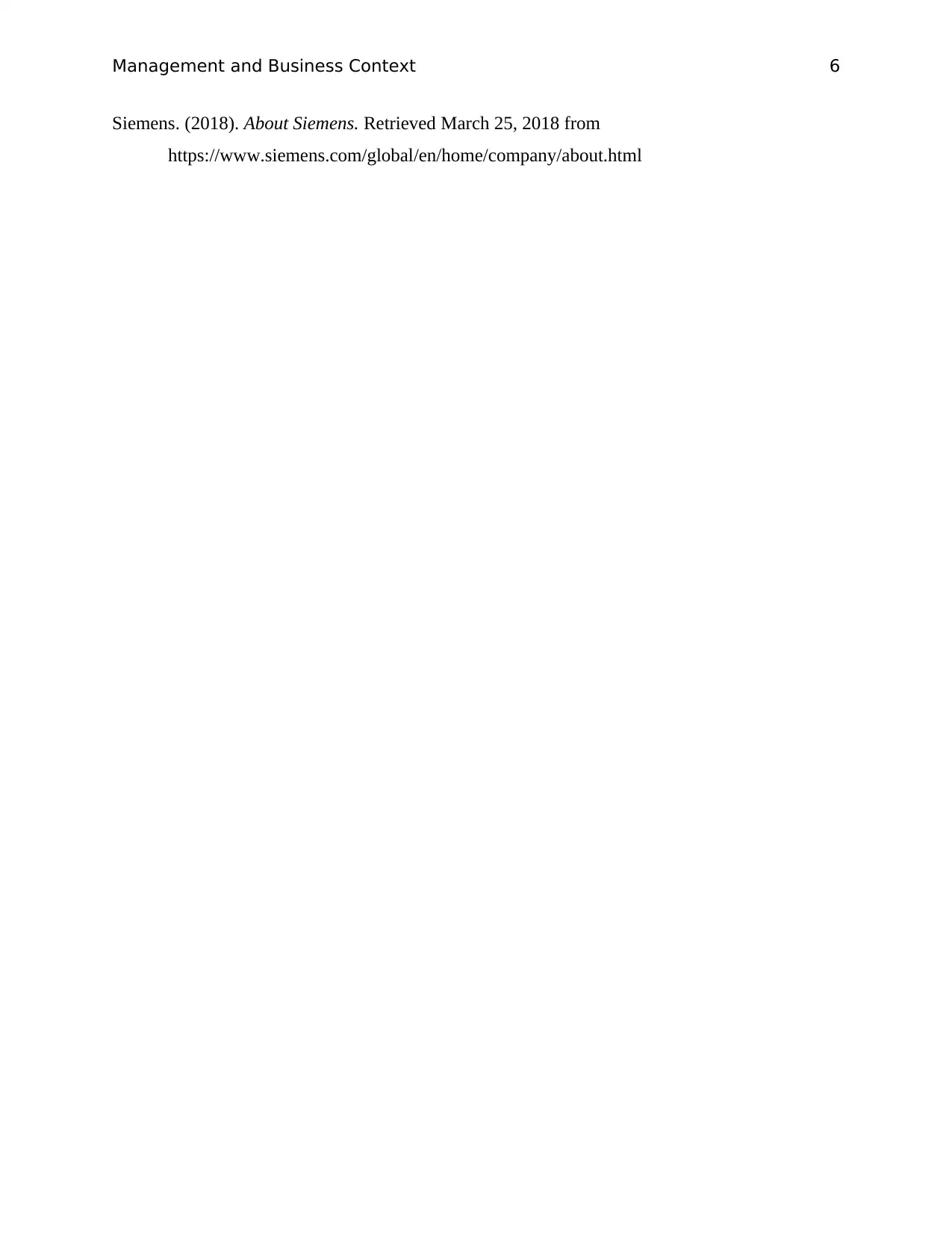
Management and Business Context 6
Siemens. (2018). About Siemens. Retrieved March 25, 2018 from
https://www.siemens.com/global/en/home/company/about.html
Siemens. (2018). About Siemens. Retrieved March 25, 2018 from
https://www.siemens.com/global/en/home/company/about.html
1 out of 7
Related Documents
Your All-in-One AI-Powered Toolkit for Academic Success.
+13062052269
info@desklib.com
Available 24*7 on WhatsApp / Email
![[object Object]](/_next/static/media/star-bottom.7253800d.svg)
Unlock your academic potential
Copyright © 2020–2025 A2Z Services. All Rights Reserved. Developed and managed by ZUCOL.





